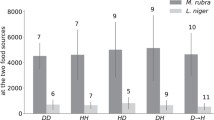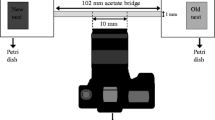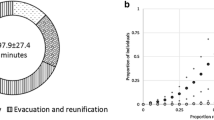Summary
This paper describes the food recruitment strategy of the antTetramorium bicarinatum, at both the individual and collective levels. The general organisation of recruitment used by this species during the exploitation of sucrose solutions shows similarities with group recruitment described for other species. However, our experiments demonstrate that inT. bicarinatum, the first trail laid by a recruiter during its return trip to the nest is more efficient than in other species using group recruitment, for exampleTetramorium impurum. Moreover, the efficiency of the first trail of aT. bicarinatum recruiter is comparable with that ofTapinoma erraticum, a species that uses mass recruitment. Despite the efficiency of the trail, choice experiments show that the recruited workers prefer to follow the leader rather than the first trail, suggesting the emission of a more attractive signal by the leader on its way back to the food. The function of the leader in this strategy is discussed in terms of collective decisions.
Similar content being viewed by others
References
Baroni Urbani, C., 1979. L'écologie des fourmis: problèmes et perspectives.C. R. UIEIS sct française, Lausanne, pp. 1–15.
Beckers, R., J. L. Deneubourg, S. Goss and J. M. Pasteels, 1990. Collective decision making through food recruitment.Ins. Soc. 37:258–267.
Beckers, R., J. L. Deneubourg and S. Goss. Modulation of trail laying in the antLasius niger (Hymenoptera: Formicidae) and its role in the collective selection of a food source.J. Ins. Behav., in press.
Cammaerts, M. C., 1977. Recrutement d'ouvrières vers une source d'eau pure ou sucrée chez la fourmiMyrmica rubra L. (Formicidae).Biol. Behav. 2:287–308.
de Biseau, J. C., J. L. Deneubourg and J. M. Pasteels, 1991. Collective flexibility during food recruitment in the antMyrmica sabuleti (Hymenoptera: Formicidae).Psyche 98:323–336.
de Biseau, J. C., J. L. Deneubourg and J. M. Pasteels, 1992. Mechanisms of food recruitment in the antMyrmica sabuleti: an experimental and theoretical approach. In:Biology and Evolution of Social Insects (J. Billen, Ed.), Leuven University Press, Leuven, pp. 359–367.
De Bruyn, G. J., 1977. A comparative study of recruitment in ants.Proc. of the 8th Intern. Congress I. U.S.S.I., Wageningen, pp. 292–293.
Deneubourg, J. L., S. Aron, S. Goss and J. M. Pasteels, 1990. The self-organizing exploratory pattern of the Argentine ant.J. Ins. Behav. 3:159–168.
Fowler, H. G. and L. Crestana, 1987. Group recruitment and its organization inCamponotus blandus (Fr. Smith) (Hym.: Formicidae).Revta bras. Ent. 31:55–60.
Hölldobler, B., 1971. Recruitment behavior inCamponotus socius (Hym.: Formicidae).Z. Vergl. Physiologie 75:123–142.
Hölldobler, B., 1978. Ethological aspects of chemical communication in ants. In:Advances in the study of behavior (Vol. 8), Academic Press, Inc., New York-San Francisco-London, pp. 75–115.
Lenoir, A. and P. Jaisson, 1982. Evolution et rôle des communications antennaires chez les insectes sociaux. In:Social Insects in the Tropics (P. Jaisson, ed.), Université Paris Nord, Paris, pp. 157–180.
Maschwitz, U., 1975. Old and new trends in the investigation of chemical recruitment in ants.Proc. Symposium IUSSI, Dijon, pp. 47–57.
Maschwitz, U. and P. Schönegge, 1977. Recruitment gland ofLeptogenys chinensis. A new type of pheromone gland in ants.Naturwissenschaften 64:589.
Möglich, M. and B. Hölldobler, 1975. Communication and orientation during foraging and emigration in the antFormica fusca.J. Comp. Physiol. 101:275–288.
Pasteels, J. M., J. L. Deneubourg and S. Goss, 1987. Transmission and amplification of information in a changing environment: the case of insect societies. In:Law of Nature and Human Conduct (I. Prigogine and M. Sanglier, Eds.), G.O.R.D.E.S., Bruxelles, pp. 129–156.
Traniello, J. F. A., 1977. Recruitment behaviour, orientation, and the organization of the foraging in the Carpenter antCamponotus pennsylvanicus De Geer (Hymenoptera: Formicidae).Behav. Ecol. Sociobiol. 2:61–79.
Verhaeghe, J. C., 1982. Food recruitment inTetramorium impurum (Hymenoptera: Formicidae).Ins. Soc. 29:67–85.
Verhaeghe, J. C., P. Champagne and J. M. Pasteels, 1980. Le recrutement alimentaire chezTapinoma erraticum (Hym. Form.).Biol-Ecol. méditerranéenne 7:167–168.
Verhaeghe, J. C. and J. L. Deneubourg, 1983. Experimental study and modelling of food recruitment in the antTetramorium impurum (Hyrn. Form.).Ins. Soc. 30:347–360.
Wilson, E. O., 1962. Chemical communication among workers of the fire antSolenopsis saevissima (Fr. Smith). I. The organization of mass-foraging.Anim. Behav. 10:134–147.
Author information
Authors and Affiliations
Rights and permissions
About this article
Cite this article
de Biseau, J.C., Schuiten, M., Pasteels, J.M. et al. Respective contributions of leader and trail during recruitment to food inTetramorium bicarinatum (Hymenoptera: Formicidae). Ins. Soc 41, 241–254 (1994). https://doi.org/10.1007/BF01242295
Received:
Revised:
Accepted:
Issue Date:
DOI: https://doi.org/10.1007/BF01242295




